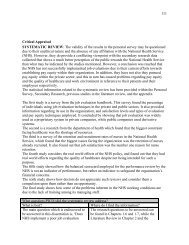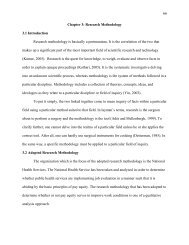13 Chapter 2: Critical Literature Review 2.1 ... - Dissertation
13 Chapter 2: Critical Literature Review 2.1 ... - Dissertation
13 Chapter 2: Critical Literature Review 2.1 ... - Dissertation
Create successful ePaper yourself
Turn your PDF publications into a flip-book with our unique Google optimized e-Paper software.
56primary participants for the survey were nurses and clinics (Kahya, 2006). The primary data wasextracted from around 90 participants, out of which the larger number was that of nurses and thesmaller number was that of clinics.It is essential to highlight that the purpose of this research, unlike other certain researchesdiscussed in this paper, was not to determine possible errors that were being ignored or overseenin the implementation of the NHS but to identify possible areas and methods for improvement.The research initiated by highlighting the fact that recent economic trends had puthospitals and medical institutions into a position where they have no other option but to bringabout transformations in their human resource infrastructure. Generally, these transformationshave incorporated the heavy remodeling of the human resource infrastructure in an attempt to cutback on costs. The research highlights the fact that other medical institutions and hospitals havecountered the same scenario by incorporating a heavy degree of performance-basedremuneration in their human resource infrastructure (Kahya, 2006). This functions primarily byremunerating employees on the basis of the targets that they manage to achieve. The researchfurther sheds light on the fact that this modernization of human resource systems is often broughtabout by either allotting the employee with a fixed pay while linking it to a job evaluation scorefor which the employee is periodically tested, or a scenario where the employee's pay isconsidered for continuous revision with regard to performance scores.The research diverted a considerable degree of attention to the fact that a large number ofhospitals and medical institutions chose to adopt the point-based job evaluation system.According to the author, the point-based system, when implemented on white collar positions,was based heavily on skill-oriented, responsibility-oriented, effort-oriented, and workingcondition-orientedfactors. Skill-oriented factors included those such as knowledge, education,





